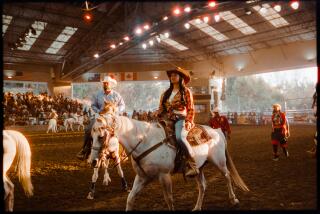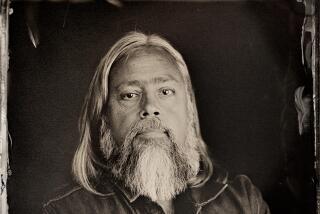‘Land Run’ Centennial Likened to ‘Germans Celebrating the Holocaust’ : Oklahoma: At noon Sept. 16, 1893, a volley of gunshots sent more than 100,000 people surging across imaginary lines in the largest scramble for free land the world had ever seen. Indians were the losers.
- Share via
OKLAHOMA CITY — On a sizzling September day in 1893, a volley of gunshots sent more than 100,000 people surging across imaginary lines in the largest scramble for free land the world had ever seen.
They came on foot and horseback, in wagons, on bicycles and by train, hoping to stake a homestead in the fabled Cherokee Strip, 7 million acres that were home to buffalo and Indians.
Oklahoma’s buffalo are mostly gone now, except for a small herd in a government refuge. But Indians remain (the last census showed Oklahoma with the largest Indian population of any state), and many are outspoken in their criticism of the current celebration commemorating the land run.
“To us, it’s analogous to the Germans celebrating the Holocaust,” said Sherman Bold Warrior, administrative assistant to chairman Genevieve Pollak of the Ponca tribe. “It amounts to the same thing. In the western movement of the dominant culture, 95% of the native population was wiped out.”
“It was devastating to the native people in Oklahoma,” said Wilma Mankiller, chief of the Cherokee Nation of Oklahoma. “That is being totally overlooked. I don’t think that ever occurs to people because they don’t think of Oklahoma as being Indian territory where many different native peoples lived before statehood.”
Dr. John Ogle, an Enid physician and president of the Cherokee Strip Centennial Foundation, said the point of the centennial was to mark history, not celebrate.
“History is history,” Ogle said. “We can’t change it. We need to make sure it is told as accurately as it can be, and now we need to go on and deal with issues today that would help all our citizens.”
Chief Charley Dawes of the Ottawa tribe agrees on that point.
“It’s a historic event,” Dawes said. “Like any centennial, it should be noted.”
But Dawes also joined other Indians in a protest of a life-size statue for Ponca City that depicts a man who has just leaped from his horse squatting down as he drives a claim stake into the ground.
The original title was, “This Land is Mine.” After protests by the Poncas, Ottawas and Cherokees, it was changed to “Holding the Claim.”
By 1893, members of the Cherokee tribe had been removed from their homeland in the southeastern United States, some voluntarily in 1828, others by force over the Trail of Tears in 1838, and resettled in what is now northeastern Oklahoma.
The 226-mile-wide Cherokee Strip, technically the Cherokee Outlet, had been set aside by the federal government to give the Cherokees a way to get to the buffalo-rich plains.
In 1866, the federal government asked the Cherokees to sell portions of the strip to “friendly” Indians. By the time of the land run 27 years later, the fourth of five such events that lured settlers to Indian Territory, the strip was home to the Osage, Pawnee, Kaw, Ponca, Tonkawa, Otoe and Missouria tribes.
At noon Sept. 16, 1893, the sound of cavalry guns opened the strip to homesteaders. Trains packed so full that men rode on rooftops and hung from the sides, puffed southward from Kansas. To keep it fair, the trains could move only at 5 m.p.h., as fast as a horse could run.
By evening, tent cities had sprouted on the plain and the 40,000 to 50,000 lucky participants were lined up at nine land offices to register their claims.
Ogle, whose grandfather participated in the run, expressed frustration over three years of fruitless attempts to draw Indians into plans for the centennial.
“We had some really neat things we thought would be interesting to do to tell the Native American story,” he said. “But there was virtually no communication with them.”
The planners eventually contacted Gerald Walker, president of Oklahoma City University, “and through him we got two Native American teachers who helped us outline the educational plans for the centennial,” Ogle said.
Ogle emphasizes that two years of planning and 90% of foundation funds went into developing the educational aspects of the event, which began in April, and only five months of planning and no money into the celebration.
Next year, he said, a statue of an Indian will be dedicated at Enid; money raised through sales of small bronze replicas will go toward scholarships for Indians.
“They don’t want to hear that,” Ogle said of the Indian protesters. “All they hear is the bad things.”
“We are not just some disgruntled people who want to create problems,” countered Mankiller. “We have genuine concerns about how our history is portrayed, whether there will be accurate reporting of how the land run impacted the tribes.”
The Cherokee leader made note of the United Nations’ proclamation making 1993 “the year of indigenous people.”
“What did we do in the United States?” she asked. “We issue a postage stamp commemorating the land run.”
More to Read
Sign up for Essential California
The most important California stories and recommendations in your inbox every morning.
You may occasionally receive promotional content from the Los Angeles Times.













